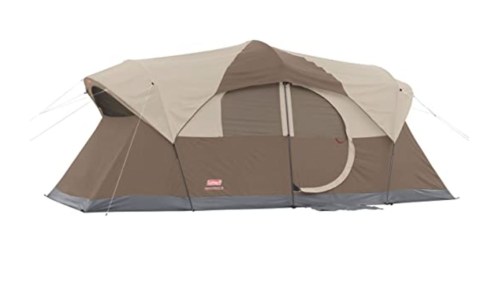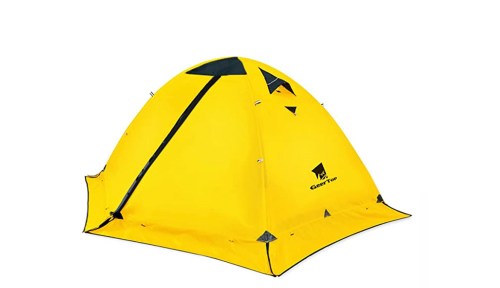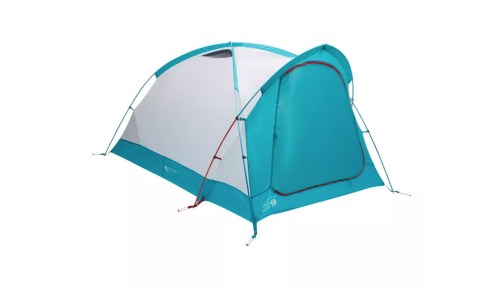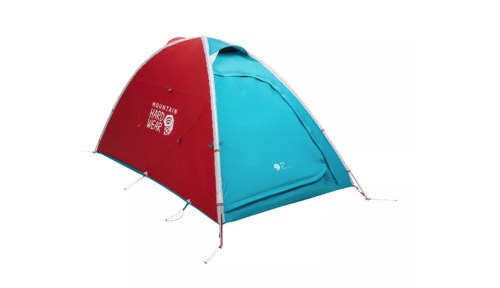Our editors independently select these products. Making a purchase through our links may earn Well+Good a commission
The Best 4-Season Tents for Year-Round Camping Adventures
Excited for your next outdoor adventure? These are the 8 best 4 season tents that will keep you protected from the elements.

Since the phrase “social distancing” catapulted itself into our everyday vocabulary, camping trips, for many, have replaced vacations to more crowded locations. Reconnecting with nature and doing it away from other people has become increasingly intriguing, even for those who have never been campers before. For those new to the camping scene, you’ll need to start with 4- season tents (yes, camping can be an all-year-long hobby, provided you have the right gear and equipment).
Experts in This Article
Charlie Ranahan is the Global Product Line Manager, Equipment, at Mountain Hardware.
Kelsey McGrew is an outdoor expert who does public relations for brands like CamelBak, HOKA ONE ONE, Mammut, Mountain Hardwear, the National Forest Foundation, among others.
The best 4-season tents

Thule Tepui Explorer Kukenam 3 Tent — $2,000.00
If sleeping on the ground is just *not your thing,* may we suggest this 4-season tent that sets up on the roof of your car? The fabric is UV-, mold- and water-resistant. The tent includes a high-density foam mattress for optimal comfort, and there are four internal pockets for gear storage and mesh panels throughout for maximum airflow and ventilation.
Pros: includes a foam mattress, not affected by wet or cold ground, all-season tent
Cons: heavy, extremely expensive, only one door, doesn’t work on smaller cars

REI Co-op Arete ASL 2 Tent — $449.00
At just over six pounds, this heavy-duty tent is more lightweight than some competitors, and it’s reasonably priced as well. The four-pole design lends stability to the structure so that it can withstand winds and harsh weather. It has one large door and a vestibule that covers the door to ensure rain won’t come inside your tent. Adjustable vents help with condensation, and roof pockets and hang loops help store your gear.
Pros: good price, lightweight, reflective detailing, color coded for easy setup, great in wind and rain
Cons: footprint sold separately, only one door, vestibule is somewhat small

The North Face Mountain 25 Tent: 2-Person 4-Season — $690.00
This lightweight, 4-season tent is great for camping and mountaineering. There is a bucket floor which helps to keep water out, and a removable rain fly for nasty weather. The tent is tested to keep you warm when temperatures dip to -60F (not that you should hang out in -60F weather if you can help it). There are eight interior pockets for storage and the whole thing weighs under nine pounds.
Pros: great in extremely cold conditions, light enough to carry, multiple interior pockets for storage, lifetime manufacturer warranty
Cons: expensive, only covers 32 square feet of floor space

Coleman WeatherMaster 10-Person Outdoor Tent — $300.00
This absolutely massive tent fits three queen-sized air mattresses, and has a hinged-door for easy access in and out. Angled windows allow you to keep them open during wet weather, while simultaneously allowing air to flow. This tent can withstand strong winds, and has a waterproof floor. Reviews say it can be set up in around 15 to 20 minutes. It also weighs about 30 pounds, so this tent is mainly for car camping.
Pros: name recognition, great for large families, waterproof, allows you to stand inside
Cons: extremely heavy, not for backpacking, some reviews say poles bend in extreme heat or cold

GEERTOP 2 Person Tent for Camping 4 Season Waterproof Ultralight Backpacking Tent 2 People Double Layer All Weather Easy Setup Tent — $146.00
This tent is lightweight with a 3,000mm waterproof floor. High quality mesh and nylon will provide ventilation as well as warmth in extreme conditions. The affordable tent sleeps two and is great for hiking, backpacking, and camping. Perfect for all seasons, this tent has two doors, mesh windows, and two vestibules.
Pros: fast and free shipping, super affordable, double layers, UV protection, two colors available, great in snow
Cons: some complain of moisture inside the tent, some reviews say there are issues with leaking

Outpost™ 2 Tent — $600.00
This mountain climbing tent is fairly lightweight at under six pounds, and can sleep two people. It features two large D-shaped doors and mesh lining for extra ventilation. There are multiple guyout and guyline points, which is especially important when using this tent in windy conditions. “All of Mountain Hardwear’s tents are free of flame-retardant chemicals—these can be hazardous to the user and some are known to be cancer causing,” says McGrew. “As a consumer I always look for that when shopping for tents or other outdoor gear!”
Pros: free of flame-retardant chemicals, lightweight, two doors, reflective accents, great in snow and wind
Cons: expensive, doesn’t fit tall campers or extra-long sleeping bags

AC™ 2 Tent — $650.00
This two-person tent is for high alpine climbing, and is super light—it weighs under four pounds. It’s perfect for windy conditions, and performs extra well on high-altitude climbs. Its small footprint gives you options on where to set up, and there are reflective accents for extra visibility at night. There are front and rear areas for ventilation as well as a mesh, D-shaped door. You can buy a coordinating vestibule separately for more space.
Pros: detachable/optional vestibule, small footprint, 4,000mm waterproof floor, two large vents at the top, lightweight, strong in windy condition
Cons: smaller sleeping space, expensive, single wall tent, no “frills”

Trango™ 3 Tent — $820.00
This highly rated tent is great for mountaineering, as well as glacier camping and winter camping. It can sleep up to three people, and has both a rear and front door for convenience. A bathtub-style floor helps shield you from wet elements, and mesh panels provide ventilation. The tent is specifically designed to function as a mountain base camp tent, and is free of flame-retardant chemicals.
Pros: a color coded system makes it easy to set up, dual sliders on doors, good height, sturdy, great in windy conditions
Cons: expensive, condensation can accumulate if not vented, heavy when backpacking
If you’re clueless on camping, Kelsey McGrew, an outdoor expert who does public relations for brands like CamelBak, HOKA ONE ONE, Mammut, Mountain Hardwear, the National Forest Foundation, among others, can guide you on what to look for when buying a tent. “Space is key,” McGrew says. “How many people will you have sleeping in the tent? Will there be dogs? I love a four-person tent for just my husband and I because we have two dogs that also sleep in there with us.”
She also encourages you to research and purchase a vestibule. “Vestibules are the ‘mud room’ of tents,” McGrew adds. “The more people or the rainier it’ll be, the more space you’ll want for your shoes and gear that you can store away from the elements but not inside the sleeping part of the tent.” Other key things to keep in mind are ease of set-up and weight of the tent, particularly if you’re backpacking.
Since this list is about year-round options, Charlie Ranahan, Global Product Line Manager, Equipment, at Mountain Hardware has some expert advice to share as well. “When shopping around for a 4-season tent, there are three main tenants to evaluate: waterproofness, structural integrity, and ventilation,” says Ranahan.
“For waterproofness, make sure you have a full coverage fly and coated fabrics with a rating of at least 2,000mm. Additionally, an increased water resistance rating on the tent floor will protect you from wet ground and snow,” Ranahan adds. “A reliable tent structure will allow you to sleep and rest safely without risk of collapse,” especially during high winds, Ranahan says. “Look for tents with direct connection loops located at clip points that allow the user to secure the tent fly to the pole structure.”
As far as ventilation, it’s important to be able to limit the buildup of precipitation inside the tent. “High / low vents and additional sliders on door zippers are two specific examples of ventilation design,” Ranahan explains. “On the flip side, it’s equally important to have the ability to completely close all mesh panels and doors for increased warmth,” he adds.
With the expert tips and our trusted picks above, you can set out on an enjoyable and safe adventure any time of the year. Happy trails!
Want to be the first to hear about the latest (and greatest) SHOP product drops, custom collections, discounts, and more? Sign up to have the intel delivered straight to your inbox.
Sign up for the Well+Good SHOP Newsletter
Get exclusive deals on wellness, beauty, fitness, and food products that have been hand-picked by our editors.
Got it, you've been added to our email list.









